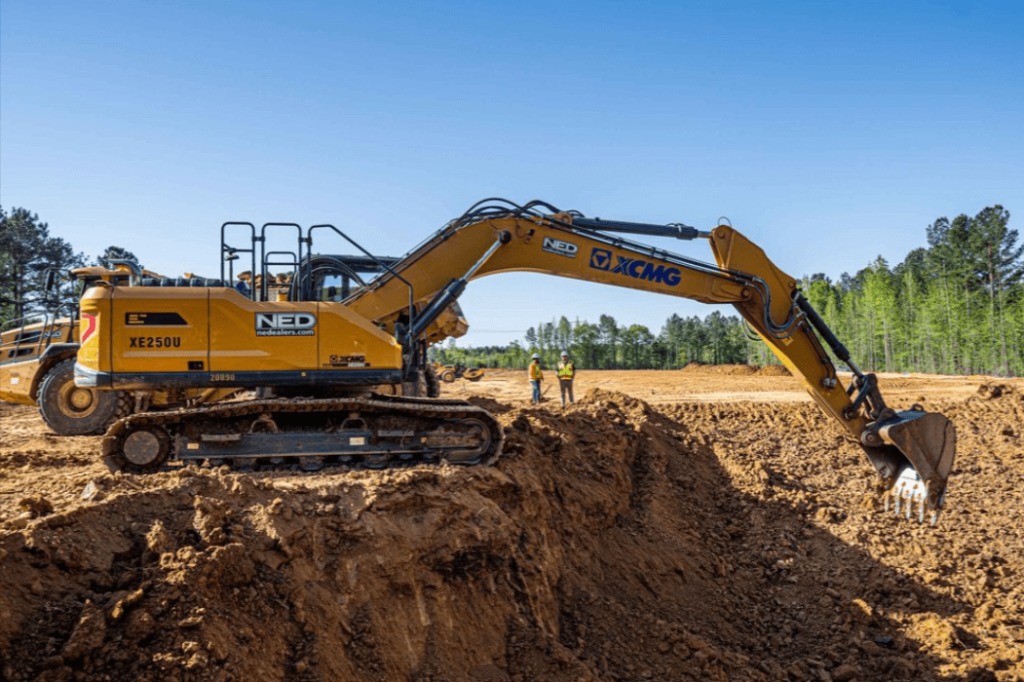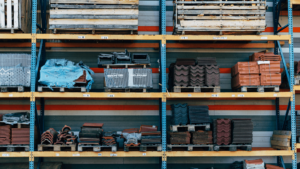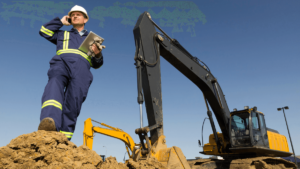Most construction companies eventually decide to sell some of their construction equipment.
There are many reasons for this, from wanting to make the most of a machine that’s nearing the end of its useful life to boosting efficiency by selling idle equipment.
Whatever the reason, you’ve reached the decision, but you’re not entirely sure how to approach the upcoming process.
Well, you’ve come to the right place!
In this article, we’ll outline the six steps you must take to sell your construction equipment successfully.
Let’s jump right in!
In this article...
1. Prepare Your Equipment for Sale
First things first, your equipment needs to be ready to go up for sale.
That means you have to do a maintenance check and clean the machinery so that potential buyers see it in the best possible condition.
Well-maintained equipment will also justify the price you define, and it signals reliability.
Both of these factors can help you quickly land a customer.
Then, if the new owner is satisfied with your equipment’s condition and performance, you’re looking at a potential return customer.
So, how should you prepare your equipment for sale?
For starters, a thorough inspection will help you identify any issues that could lower your equipment’s value on the market.
Then, you can move on to addressing regular maintenance needs such as changing oil, topping up fluids, or inspecting the cabin’s HVAC systems.
Here’s a checklist you can go through before listing your equipment for sale.

The last item on the list concerns the cleanliness of your machine.
This may seem less important, but investing time in presentation matters a lot.
Here are a couple of areas to pay special attention to:
| Engine compartment | A clean engine suggests proper maintenance and transparency because it makes it easier to spot potential leaks or other issues. |
| Tires/tracks and undercarriage | Dust-free, gleaming tires or tracks indicate optimal performance and longevity. |
| VIN tag | A legible VIN tag reassures buyers of the equipment’s authenticity and legal standing. |
Keep in mind that there are alternatives if you don’t have the time to do the deep cleaning yourself.
For example, well-known heavy equipment auctioneer Ritchie Bros. offers various equipment refurbishing services directly on auction sites.
If you watched the video above, you saw that these services include interior and exterior cleaning, sandblasting, welding and metal work, decal replacement, upholstery repair, and more.
Whether you opt for these services or do it yourself, the goal is always to present well-maintained equipment to potential buyers.
So make sure to do a maintenance check and clean it thoroughly.
2. Set a Competitive Price
Next up, you’ll need to define a competitive price for your equipment.
But, if you’re not careful, you can end up setting a price that’s either too high or too low, thereby turning away potential buyers for different reasons.
So, what can you do to attract customers instead?
Well, you need to apply that elbow grease and do some old-fashioned research first.
You’re not the only company looking to sell equipment, and the post-pandemic boom in online equipment sales and purchases testifies to that.
However, the good thing about it is that you can easily compare your intended offer with other listings to determine the most competitive pricing.
Online marketplaces offer unprecedented access to a wide range of options locally, regionally, and globally, and the search function, like the one from Equipment Trader, makes it easy to find what you need quickly.

The available listings reveal different factors that impact the price, from the age, usage, and overall condition of the equipment to different brands and their perceived value.
Of course, another thing to keep in mind is the ever-changing market.
Staying on top of market fluctuations can be tricky, but this is where consulting industry experts can be very helpful.
Experts can help you understand current supply and demand dynamics and determine when specific equipment types could fetch the best price.
In other words, sellers who are up to speed with current and projected market conditions can time their listings to secure the best possible deal.
Nevertheless, you can’t set the price without considering the negotiation process.
No matter where you intend to sell your equipment, prospective buyers will typically offer less than what you’re asking for at first and try to lower the price.
That’s why it’s essential to know the lowest possible offer that’s acceptable for you.
As explained by sales and branding expert Bader El Fellah, negotiation tactics like anchoring are essential to make the most of every sale.

Setting an initial price that’s a bit higher than what you want to get will help you offset any lower offers while convincing the buyer that you’re open to reaching an agreement.
To sum up, know your asking price and make it competitive, and inquiries will soon follow!
3. Gather the Documentation
Gathering all the equipment documentation helps you effectively seal the deal.
Documents that confirm your ownership of the machine are critical to making the sale happen in the first place, but there is additional paperwork you need to consider.
Having readily available warranties, maintenance logs, safety manuals, or other certifications gives added value to your equipment when it hits the market.
The reason why is simple: paperwork builds credibility and trust.
If you were in a buyer’s position, you would want to be certain that you’re investing in the right piece of equipment.
For example, buying used equipment with a warranty means extra security in case of major malfunctions.
This is why some listings, like Boom & Bucket, immediately highlight whether the warranty is available or not.

Each Boom & Bucket listing also contains detailed inspection reports and photographs of the entire machine, starting with serial plates.
Meanwhile, many others, like IronPlanet, specify whether the equipment has an operating and safety manual and additional documentation.
Of course, keeping track of all the equipment documentation is challenging regardless of the size of your fleet, but it gets more challenging the more your business grows.
Fortunately, asset management tools like GoCodes Asset Tracking boost visibility by giving you a quick overview of vital asset information and making all its paperwork readily available.

Adding and accessing relevant documentation from any device is a breeze.
Plus, using cloud storage, GoCodes Asset Tracking lets you store multiple attachments for every asset, from PDF documents to photos and videos.
So, gather all the relevant documents for the equipment you want to sell.
And to have it all in one place and readily available, help yourself with good cloud-based software.
4. Take High-Quality Photos and Videos of the Equipment
High-quality photos and videos of your equipment are essential if you want to attract buyers.
Let’s consider a scenario where you’re choosing between two dozers of the same model and brand that cost almost the same and have similar usage hours.
It would be a tough choice to make—if one wasn’t listed with just a few grainy images.

Meanwhile, the other is documented at high resolution and from all angles, making it easy to see key details of both the interior and the exterior.

Which one would you pick?
That’s right, there is a reason why listings need to include visually appealing images.
Not only are such listings better at capturing and keeping the buyers’ attention, but they inspire trust.
Low-quality photos make it easier to conceal small damages and imperfections, so a buyer might hesitate to reach out or make an offer.
On the other hand, clear and detailed visuals immediately communicate professionalism and reliability.
More importantly, a potential customer can accurately and conveniently assess the state of your equipment without needing to reach out with dozens of questions.
Good visuals empower buyers to make an informed decision independently, bringing them closer to finalizing the deal.
So, now that we’ve established the benefits of high-quality images, here’s how to make them happen.
There are a couple of tips to consider, from ensuring proper lighting to stabilization, but first, you need to think of the best way to combine wide shots and close-ups to capture the most relevant details.
Next, the setting itself is crucial for presenting your equipment in the best possible light.
A warehouse is your best choice if you’re selling a forklift, but taking a couple of photos or making a video directly on the job site is better if you want to capture powerful earthmoving equipment.

You always have the option to hire someone to make 360 images or videos, but keep in mind that compelling visuals aren’t everything.
The key is to establish trust, and although Jeremie Harrison’s advice doesn’t focus on equipment listings per se, this construction project manager makes an excellent point about time-stamped photography.

Uploading recent photos assures potential buyers that this is the machinery’s most recent condition, and you can even combine these efforts with your pre-sale maintenance for total transparency.
Remember: high-quality photos and videos increase your chances of selling your equipment quickly and at the right price, so investing enough time in this step is very important.
5. List Your Equipment For Sale
Once you’ve completed the previous steps, you’re ready to list your equipment for sale.
If this is the first time you’re selling your construction equipment, the question that will surely arise at this point is what’s the best place to list your equipment.
One Reddit user looking to sell heavy equipment, attachments, and parts posted that very question but specified that the company wanted to start their own website.
The most helpful reply suggested that the key is to find an existing, well-advertised platform that attracts buyers from the local area.

Listing your equipment on multiple platforms, from online marketplaces and auction sites to social media, increases the chance it will reach the right audience.
Even selling a car requires you to post on several sites, and construction equipment attracts considerably fewer buyers.
With that said, it’s important to research selling options carefully.
Prioritize well-known, reputable online marketplaces or auction platforms such as Machinery Trader, Equipment Trader, Ritchie Bros., IronPlanet, MyLittleSalesman, Boom&Bucket, and others.
Depending on the type of equipment you’re selling and your location, you can explore additional options, such as CraneTrader or California-based Rock&Dirt, to achieve maximum exposure.

Having all your equipment for sale listed on your website is also a good idea.
Not only are you reaching a wider audience, but you also have a designated spot with detailed equipment descriptions.
Just make sure to add all the relevant information, including:
- make,
- operating hours,
- overall condition,
- year of manufacture,
- images and/or videos,
- list of asset-related documents,
- other key features like upgrades or accessories.
Then, you can use the same description and modify it where necessary before creating a listing, and user-friendly platforms will make it easy to upload your images or videos.
Now that you’ve carefully polished your listing, the only thing that’s left is to make the sale.
6. Make the Sale
Making the sale is the final step in the process of selling your construction equipment.
But even if you’ve done everything to make sure your equipment makes a splash on the market, finalizing the sale with a prospective buyer can prove challenging.
Some factors are beyond your control, such as current market conditions or specific buyer needs, so let’s focus on what you can control instead.
The number one thing is to make sure you respond to inquiries as soon as possible to create a positive impression and build trust.
No matter what you’re selling online, if you’re not responsive enough, the potential customer will take their business elsewhere.
And if they linger, a prolonged response time will create frustrations, as Nick Krummen, a Customer Support Specialist at Redtail Technology, explains.

Since first impressions create a ripple effect, negotiating the price with a dissatisfied customer would likely prove difficult.
However, let’s say you’ve made a positive impression and done everything right.
Once both sides agree on the price, it’s time to finalize the sale by preparing the sale agreement, a legally binding contract that specifies payment terms, warranties, and delivery details.
Sale agreement templates can vary drastically, but there are a couple of key elements you should always include:
| Equipment description & condition | Describe the equipment in detail, listing the make, model, year, quantity, serial number, and other unique identifiers, including any damages or modifications. |
| Purchase price & payment terms | Define the accepted payment methods and list the payment schedule, including late payment fees. |
| Delivery & transfer of ownership | Define delivery location, timeline, and related costs. Specify when ownership will be transferred. |
| Warranties & representations | Provide an overview of warranties, clearly stating what’s covered and what isn’t. |
| Liability & indemnification clauses | State which party is responsible for any damages and injuries that may occur during or after the sale. |
It’s important to draft your sale agreement carefully because you’re otherwise risking disputes and financial losses.
These can happen in several ways, but some of the most common mistakes include writing in ambiguous language and not including stipulations on compliance or liabilities.

On the other hand, crafting detailed equipment sale agreements will help you transfer both equipment and ownership documents smoothly and—finally—collect your well-earned money.
Conclusion
There you have it!
Selling construction equipment can be a lengthy process, but it’s also a rewarding journey.
Outlining the key steps and understanding what you have to offer and how is just one part of the equation.
What’s essential is to consistently follow these six steps.
Every time and for every piece of equipment you want to sell.
Remember, each step you take brings you closer to finding the right buyer for your equipment and securing a deal that maximizes your profits.
So, embrace the journey, and you’ll see how quickly a proactive mindset and hard work lead to success!










